Identification of Reservoir Water-Flooding Degrees via Core Sizes Based on a Drip Experiment of the Zhenwu Area in Gaoyou Sag, China
Abstract
:1. Introduction
2. Geological Setting
3. Materials and Methods
4. Results
4.1. Understanding of Sedimentary Facies
4.1.1. The Symbol of Depositional
The Color of Mudstone
Rock Type, Structure, and Composition
Sedimentary Tectonics
Logging Response Characteristics
4.1.2. Types and Characteristics of Sedimentary Facies
Delta Facies
Braided Fluvial Facies
Meandering Fluvial Facies
4.2. Analysis of Core Dripping
5. Discussion
5.1. Flooding Degree Identification
5.2. The Influence of Sedimentary Facies on Flooding Degree
5.2.1. Sedimentary Rhythm
5.2.2. Sedimentation Types
6. Conclusions
- (1)
- The E2s14–7 sand group in the Zhenwu area of the Gaoyou Sag has many sedimentary types and fast phase transformation. It has a set of multi-type deposits formed under the background of lake regression, mainly developing delta facies, braided fluvial facies, and meandering fluvial facies. The sand body characteristics of the various sedimentary types are different. About 35 years of water injection development has led to varying degrees of water flooding in the study area.
- (2)
- A core scale drip experiment is carried out on the sealed core of the Zhenjian 4 well. Identification standards for the water-flooding degrees of delta facies, braided river facies, and meandering river facies are established. The water-flooding degree of the delta sand body is generally weak, and the oil saturation is 24.1–40.2%, which essentially indicates no water flooding or weak water flooding. The water-flooding degree of the braided fluvial sand body changes significantly, and the variation range of the oil and water saturation measurement results is also large. The water-flooding degree of the meandering fluvial sand body is weaker than that of the braided fluvial sand body, which is mostly not flooded or weakly flooded.
- (3)
- The top permeability measurement of the positive-rhythm sand bodies in the study area is low, and the bottom permeability measurement is high. The permeabilities of the sand bodies with various sedimentary types are quite different, resulting in different water-flooding degrees. Due to the existence of the non-permeable deposition layer, the whole thick layer connected to the sand body of the heart beach is divided into several independent parts, which changes the traditional water-flooding modes of the heart beach sand body. The water-flooding degree of the river is stronger than that of the sedimentary microfacies, such as the edge beach and the heart beach.
Author Contributions
Funding
Data Availability Statement
Conflicts of Interest
References
- Li, J.; Li, X.; Gao, W.; Jiang, T. Residual oil distribution research of high water-cut stage in Tuha Oilfield. Nat. Gas Geosci. 2005, 16, 378–381. [Google Scholar]
- Jiang, Z.; Liu, Z.; Zhao, P.; Chen, Z.; Mao, Z. Evaluation of tight waterflooding reservoirs with complex wettability by NMR data: A case study from Chang 6 and 8 members, Ordos Basin, NW China. J. Pet. Sci. Eng. 2022, 213, 110436. [Google Scholar] [CrossRef]
- Feng, C.; Bao, Z.; Chen, B.; Wei, Z.; Wang, Y. Application of the single factor analysis and multifactor coupling method to the remaining oil prediction in Fuyu Oilfield. Acta Pet. Sin. 2012, 33, 465–471. [Google Scholar]
- Song, Z.; Tan, C.; Wu, S.; Yang, G.; Jin, X. Application of grey system theory and neural network technology to watered-out formation logging evaluation. Pet. Explor. Dev. 1999, 26, 90–92. [Google Scholar]
- Cui, C.; Wei, S.; Wang, Z.; Qian, Y.; Wu, Z. Response time of waterflooding in low-permeability reservoirs. Unconv. Resour. 2022, 2, 85–90. [Google Scholar] [CrossRef]
- Zhao, J.; Cheng, P.; Liu, D.; Xu, W. The application of the support vector machine to the recognition of flooding formation. Geophys. Geochem. Explor. 2008, 32, 652–655. [Google Scholar]
- Ci, X. Study and application of logging evaluation for water-flooded zone based on fuzzy mathematics and fractal theory. Prog. Geophys. 2012, 27, 1525–1532. [Google Scholar]
- Zhang, M.; Qi, M.; Lin, L. Integrated evaluation method of water flooded layer in ultra-low permeability reservoir in peripheral Daqing Oilfield. Lithol. Reserv. 2016, 28, 93–100. [Google Scholar]
- He, Z.; Cui, Z.; Chen, G.; He, Y.; Wang, X. Evaluating Residual Oil Saturation and Water-flood Degree with Hydrocarbon Ratio Logging. J. Southwest Pet. Univ. 2016, 38, 41–49. [Google Scholar]
- Shen, H.; Ma, X.; Li, H.; Wang, B.; Zhang, P.; Meng, L. A low permeable reservoir watered-out degree at the high water-cut stage identification method is discussed in this paper: To Wuliwan A reservoir as an example. Petrochem. Ind. Appl. 2017, 36, 128–130. [Google Scholar]
- Ren, J.; Tang, J.; Chen, B.; Zhao, W. Determination of the remained oil saturation for the heterogeneous watered-out layer by the production profile date. Pet. Geol. Oilfield Dev. Daqing 2017, 36, 137–140. [Google Scholar]
- Shi, Y.; Zhou, J.; Zhong, J.; Wang, C.; Zhong, X.; Zhang, S. Method and application fou identifying waterflooded layer with reconstructed resistivity curves. Well Logging Technol. 2018, 42, 42–48. [Google Scholar]
- Miao, Q.; Ling, H.; Lin, Y.; Liu, J.; Xing, D. Log interpretation method for water flooded layer in a foreign oilfield. Well Logging Technol. 2020, 44, 486–490. [Google Scholar]
- Lang, D.; Lun, Z.; Lv, C.; Wang, H. Core experimental evaluation of clastic reservoir saturation and water displacement effect: Triassic development zone in the 9th block of Tahe oilfield as an example. CT Theory Appl. 2021, 30, 311–321. [Google Scholar]
- Zhao, B.; Hou, J.; Zhang, G.; Chen, S.; Liu, Y. Sedimentary microfacies and remaining oil distribution of the Eocene Guaduas formation in Velasquez Oilfield, Columbia. J. Cent. South Univ. 2011, 42, 1385–1392. [Google Scholar]
- Sun, Y.; Chen, C. Control on the remaining oil distribution by reservoir sedimentary microfacies — an example from Shuanghe Oilfield. XJPG 2002, 23, 205–207. [Google Scholar]
- Yu, H.; Wang, Y.; Zhang, L.; Zhang, Q.; Guo, Z.; Wang, B.; Sun, T. Remaining oil distribution characteristics in an oil reservoir with ultra-high water-cut. Energy Geosci. 2022, 100116. [Google Scholar] [CrossRef]
- Xing, Y.; Wang, Y.; Bai, Y.; Lin, Y.; Wang, F.; Wei, X. Sedimentary characteristics of water flooded layers and remaining oil distribution in Fuyu Oilfield. J. Jilin Univ. 2008, 38, 128–132. [Google Scholar]
- Zhang, J.; Liu, G.; Cao, Z.; Maarten Felix, T.; Kong, Y.; Zhang, Y. Characteristics and formation mechanism of multi-source mixed sedimentary rocks in a saline lake, a case study of the Permian Lucaogou Formation in the Jimusaer Sag, northwest China. Mar. Pet. Geol. 2019, 102, 704–724. [Google Scholar] [CrossRef]
- Noronha-D’Mello, C.A.; Nair, A.; Mahesh, B.S.; Warrier, A.K.; Mohan, R.; Kurian, S. Glacial-Holocene climate-driven shifts in lacustrine and terrestrial environments: Rock magnetic and geochemical evidence from East Antarctic Mochou Lake. Palaeogeogr. Palaeoclimatol. Palaeoecol. 2021, 576, 110505. [Google Scholar] [CrossRef]
- Wu, S.; Tan, C. Braided delta deposition of E2S16 reservoir zones in block Zhen-12,Zhenwu Oilfield. J. Xi’an Shiyou Univ. 2004, 19, 1–4. [Google Scholar]
- Hou, L.; Wang, J.; Liu, Z. Evaluation of water flooded interval well logging. Acta Pet. Sin. 1999, 20, 49–55. [Google Scholar]
- Lei, X.; Zhao, C.; Zhang, Q.; Wang, P.; Xiong, R. Effect of high-multiple water injection on rock pore structure and oil displacement efficiency. Energy Geosci. 2022, 100137. [Google Scholar] [CrossRef]
- Tan, F.; Li, H.; Wu, X.; Fan, X.; Yu, H. Quantitative identification of water-flooded zones in conglomerate reservoirs—An example from theKexia Formation in the Liuzhong block of Karamay Oilfield. Oil Gas Geol. 2010, 31, 232–239. [Google Scholar]
- Tan, B.; Luca, C.; Nigel, P. Quantitative characterization of the sedimentary architecture of Gilbert-type deltas. Sediment. Geol. 2021, 426, 106022. [Google Scholar] [CrossRef]
- Zhen, D.; Zai, X.; Jiang, G. Sedimentary characteristics, genetic types and control factors of deep-water sandstones in the western Lijin Sag, China. Mar. Pet. Geol. 2020, 113, 104130. [Google Scholar]
- Zhen, H.; Wei, W.; Shang, W.; Chen, H.; Reza, R.; Jia, C. Impacts of gas properties and transport mechanisms on the permeability of shale at pore and core scale. Energy 2022, 244, 122707. [Google Scholar]
- Feng, C.; Shan, Q.; Shi, W.; Zhu, W. Reservoirs heterogeneity and its control on remaining oil distribution of K1q4, Fuyu Oilfield. J. China Univ. Pet. 2013, 37, 1–7. [Google Scholar]
- Lu, G.; Zhang, L.; Liu, Q.; Xu, Q.; Zhao, Y.; Li, X.; Deng, G.; Wang, Y. Experiment analysis of remaining oil distribution and potential tapping for fractured-vuggy reservoir. J. Pet. Sci. Eng. 2022, 208, 109544. [Google Scholar] [CrossRef]
- Zhao, X.; Zhang, S.; Yang, S.; Ju, X.; Chen, G.; Zhang, X.; Khan, D.; Zhang, Y.; Zhang, J. Controlling factors of carbonate cement and its influence on oil-water distribution of the Neoene Shawan Formation in the northern Chepaizi area, Junggar Basin, NW China. J. Pet. Sci. Eng. 2021, 206, 108942. [Google Scholar] [CrossRef]
- Zhang, S.; Liu, Z.; Jin, B.; Liu, H.; Dong, C.; Zhang, W. Formation of paleogene lithologic reservoir and distribution in Gaoyou sag, Subei basin. Nat. Gas Geosci. 2012, 23, 99–105. [Google Scholar]
- Zhou, J.; Lin, M.; Zhang, X.; Yao, Y.; Pan, F.; Yu, H.; Chen, S.; Zhang, M. Provenance system and sedimentary facies of the Member 1 of Paleogene Dainan Formation in Gaoyou Sag, Jiangsu Province. J. Palaeogeogr. 2011, 13, 161–174. [Google Scholar]
- Josep, P.; Mayte, B. Fault-slip, bed-length and area variations in experimental rollover anticlines over listric normal faults: Influence in extension and depth to detachment estimations. Tectonophysics 2005, 396, 97–117. [Google Scholar]
- Jian, T.; Yi, L.; Li, J.; Na, J.; Zhi, Y.; Ping, L. Investigation on water phase trapping mechanisms in tight gas reservoirs: Pore-scale visualization observation and core-scale flooding analysis. J. Pet. Sci. Eng. 2021, 198, 108185. [Google Scholar]
- Huang, C.; Janok, P. Facies analysis and its relation to point-sourced growth faults in river-dominated prodeltaic delta front deposits of the Cretaceous Ferron Notom Delta, Utah, USA. Mar. Pet. Geol. 2017, 81, 237–251. [Google Scholar] [CrossRef]
- Zhao, X.; Wang, S.; Yang, J.; Zhang, B.; Li, L.; Liu, X.; Wen, W.; Zhang, Y. Evaluation method for low- to ultralow-permeability reservoirs based on pore-throat structure: A case study in the eastern Nanpu Sag, Bohai Bay Basin, China. Interpretation 2021, 9, T315–T329. [Google Scholar] [CrossRef]
- Wei, X.; Zhang, T.; Liang, X.; Yao, Q.; Tang, X. Sedimentary characteristics and evolution of the 1stmember of Dainan Formation and the 1stmember of Sanduo Formation in Qutang and Haibei Sub-sags Hai’an Sag. Oil Gas Geol. 2012, 33, 265–276. [Google Scholar]
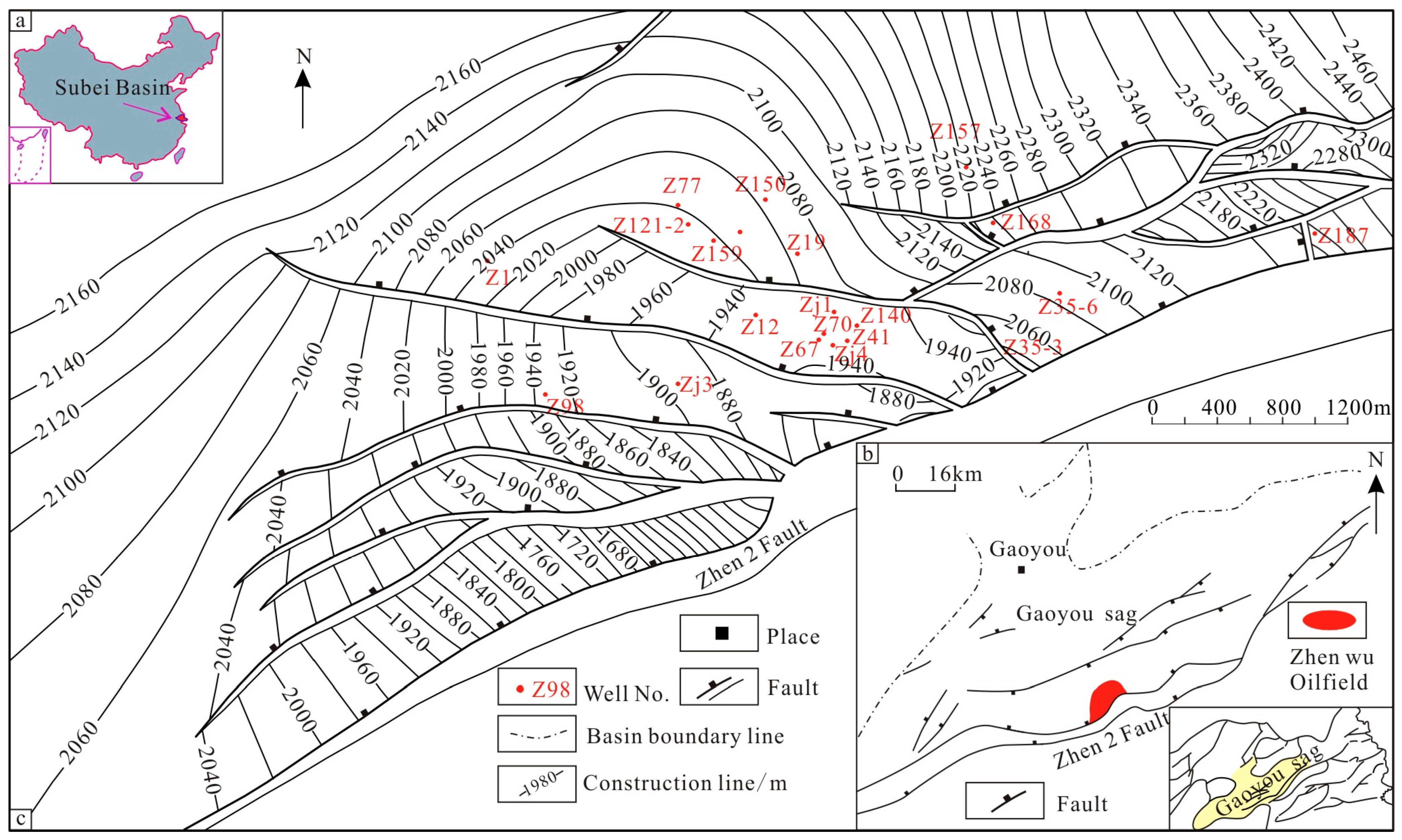

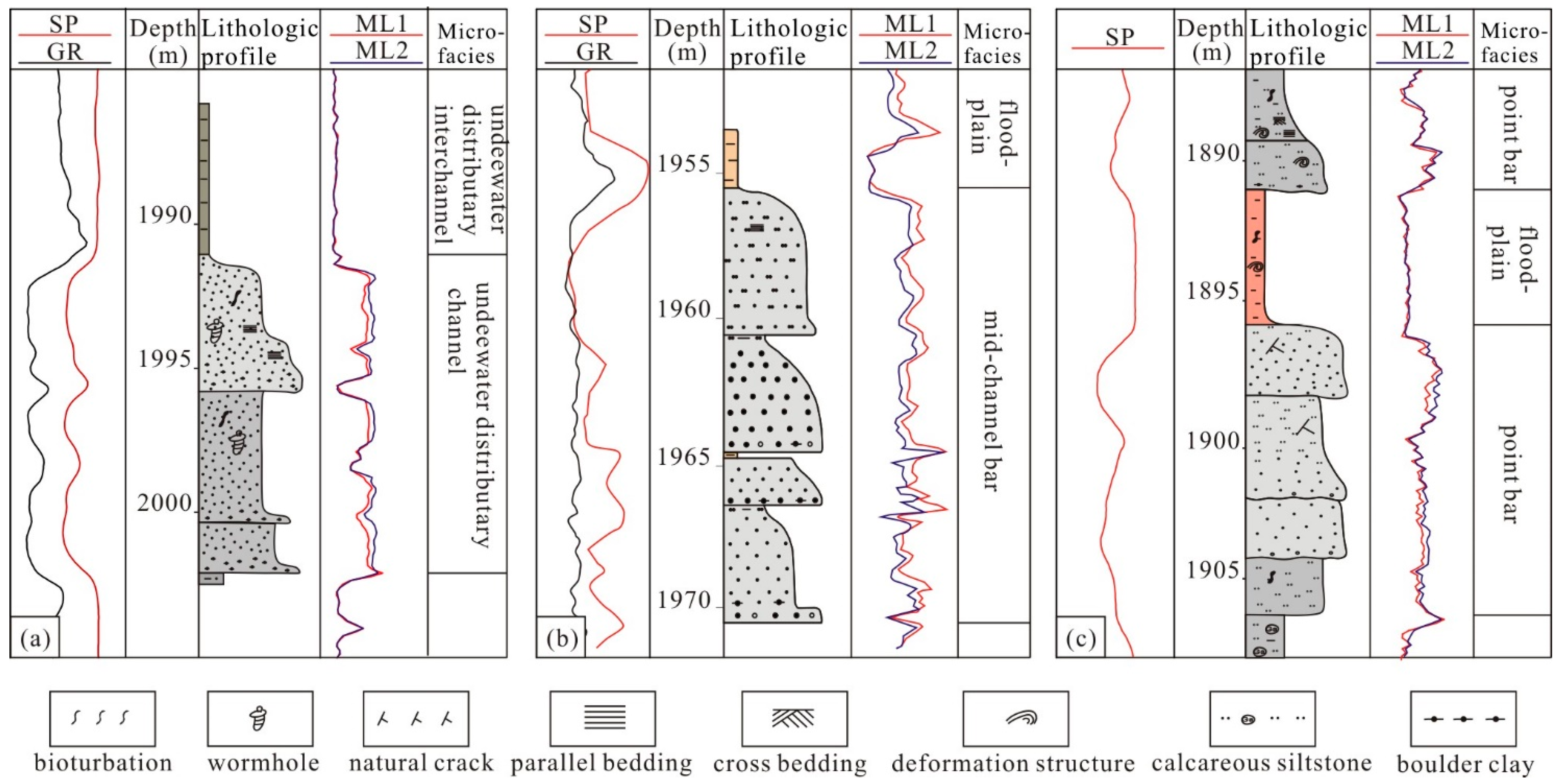

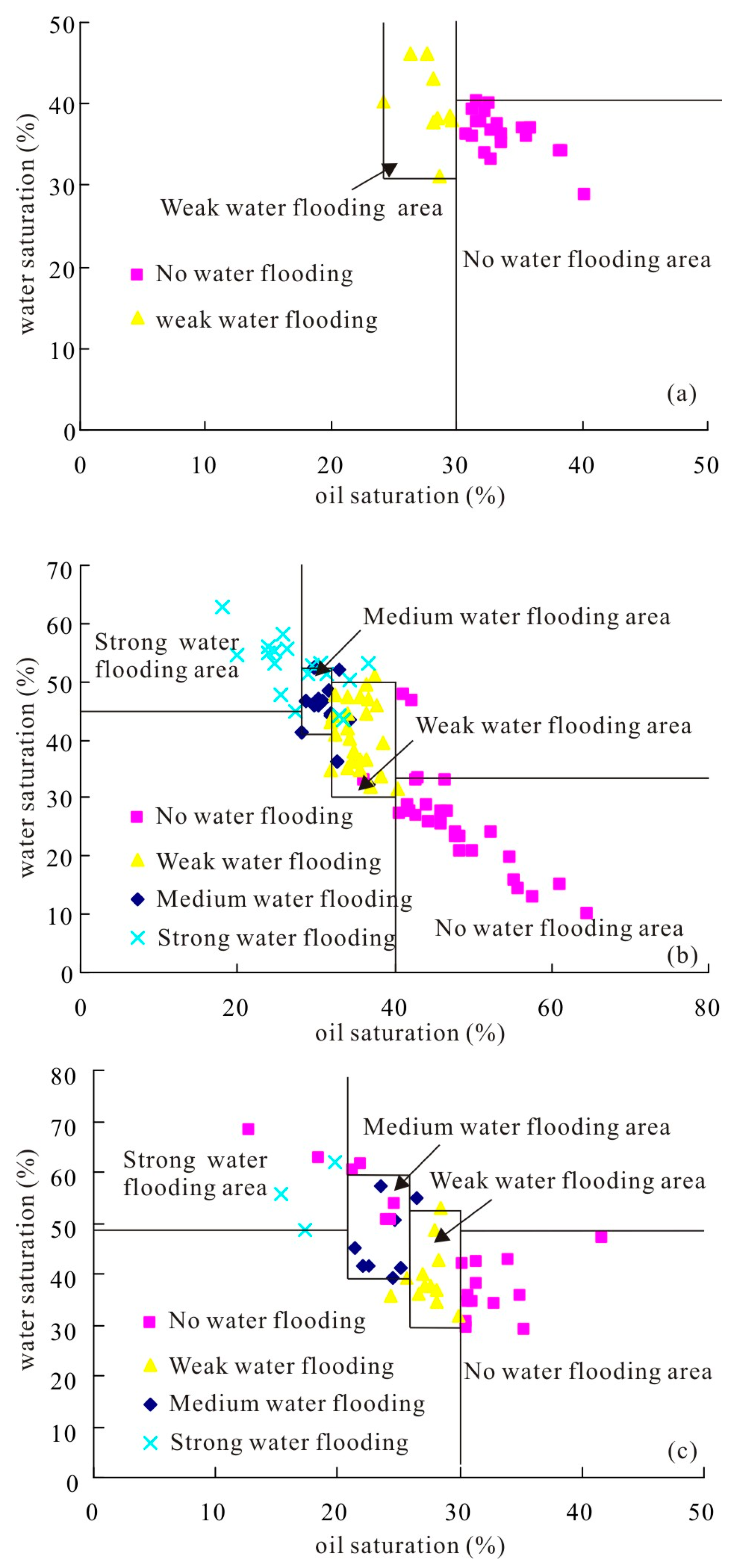
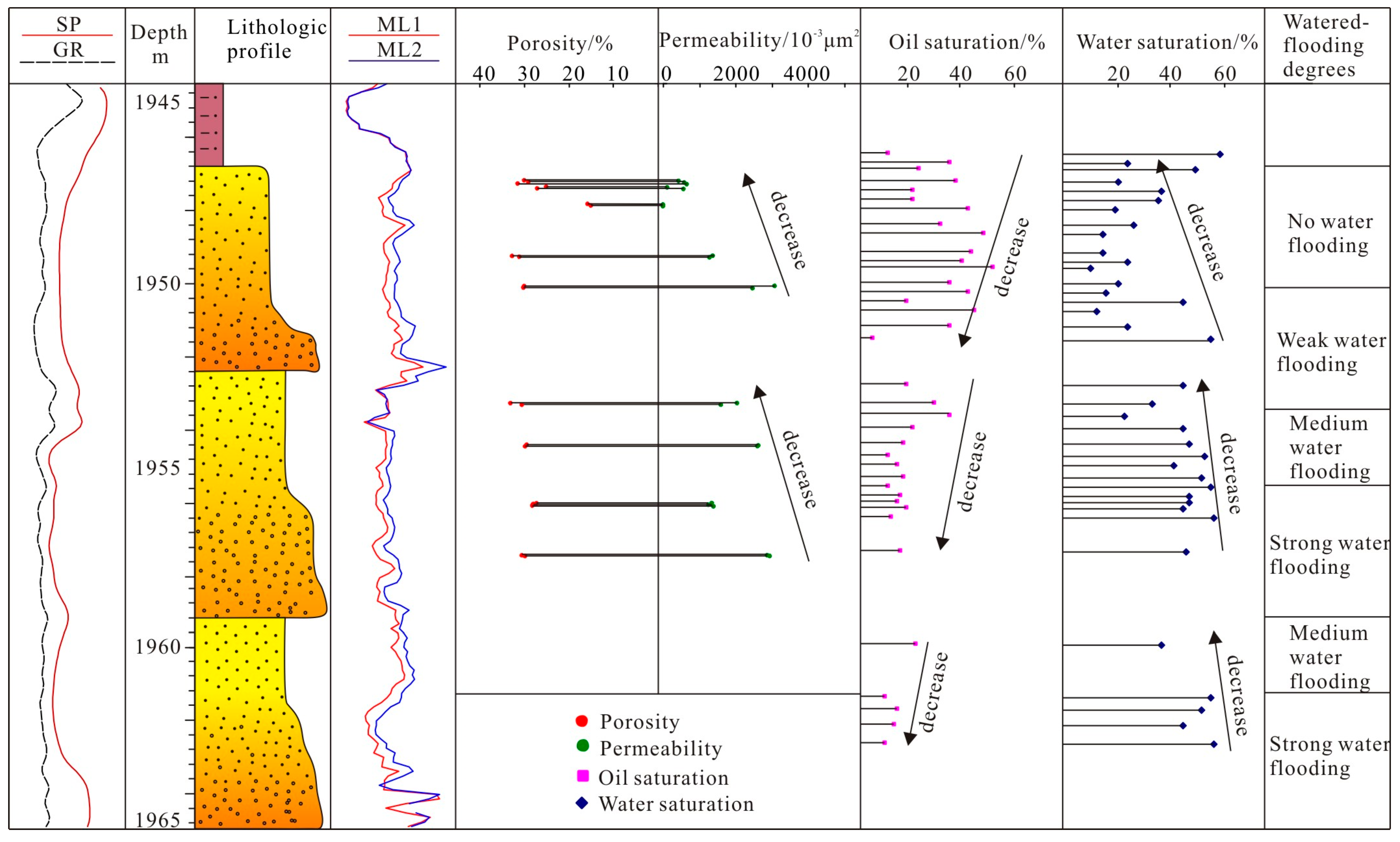
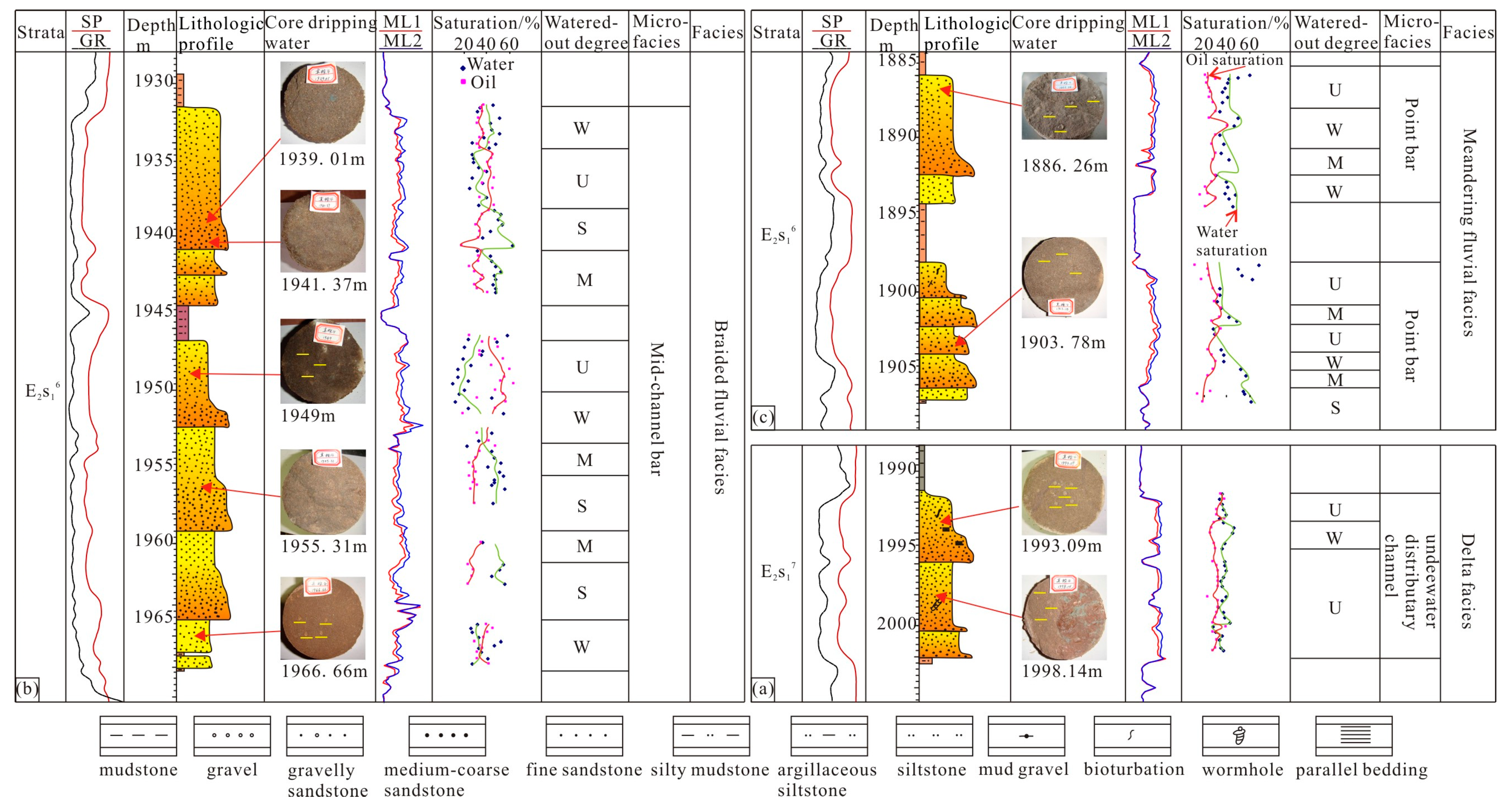
| Water-Flooding Degree | Facies | |||||
|---|---|---|---|---|---|---|
| Delta Facies | Braided Fluvial Facies | Meandering Fluvial Facies | ||||
| Oil Saturation | Water Saturation | Oil Saturation | Water Saturation | Oil Saturation | Water Saturation | |
| No water flooding | >30% | <40% | >40% | <32% | >30% | <48% |
| Weak water flooding | 24–30% | >30% | 32–40% | 30–50% | 26–30% | 30–52% |
| Medium water flooding | - | - | 28–32% | 40–52% | 22–26% | 39–60% |
| Strong water flooding | - | - | <28% | >45% | <22% | >49% |
Disclaimer/Publisher’s Note: The statements, opinions and data contained in all publications are solely those of the individual author(s) and contributor(s) and not of MDPI and/or the editor(s). MDPI and/or the editor(s) disclaim responsibility for any injury to people or property resulting from any ideas, methods, instructions or products referred to in the content. |
© 2023 by the authors. Licensee MDPI, Basel, Switzerland. This article is an open access article distributed under the terms and conditions of the Creative Commons Attribution (CC BY) license (https://creativecommons.org/licenses/by/4.0/).
Share and Cite
Ju, X.; Zhao, X.; Zhou, B.; Zhang, R.; Wu, X.; Guo, D. Identification of Reservoir Water-Flooding Degrees via Core Sizes Based on a Drip Experiment of the Zhenwu Area in Gaoyou Sag, China. Energies 2023, 16, 608. https://doi.org/10.3390/en16020608
Ju X, Zhao X, Zhou B, Zhang R, Wu X, Guo D. Identification of Reservoir Water-Flooding Degrees via Core Sizes Based on a Drip Experiment of the Zhenwu Area in Gaoyou Sag, China. Energies. 2023; 16(2):608. https://doi.org/10.3390/en16020608
Chicago/Turabian StyleJu, Xiaoyu, Xiaodong Zhao, Boyu Zhou, Ruixue Zhang, Xinyu Wu, and Dafa Guo. 2023. "Identification of Reservoir Water-Flooding Degrees via Core Sizes Based on a Drip Experiment of the Zhenwu Area in Gaoyou Sag, China" Energies 16, no. 2: 608. https://doi.org/10.3390/en16020608
APA StyleJu, X., Zhao, X., Zhou, B., Zhang, R., Wu, X., & Guo, D. (2023). Identification of Reservoir Water-Flooding Degrees via Core Sizes Based on a Drip Experiment of the Zhenwu Area in Gaoyou Sag, China. Energies, 16(2), 608. https://doi.org/10.3390/en16020608






